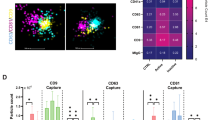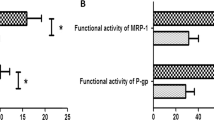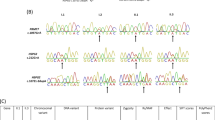Abstract
Schimke immuno-osseous dysplasia (SIOD) is a rare autosomal-recessive multisystem disorder with disproportionate growth failure, impaired T cell function, and steroid-resistant nephrotic syndrome. Recently, we presented the typical anthropometric features of SIOD. We now present data on two siblings who were initially classified as suffering from familial steroid-resistant nephrotic syndrome of unknown genetic origin. Apart from growth failure, no syndrome-specific symptoms were found until the age of 10 y. However, serial anthropometric examinations showed the development of a SIOD-like pattern with a decreased ratio of trunk to leg length in early adolescence. The growth pattern was significantly different from that seen in children with chronic renal failure of other origins. In prepuberty the siblings had proportionate short stature but developed disproportion only during adolescence. Molecular genetic analysis revealed compound heterozygosity for a known and a new mutation in the SMARCAL1 gene.
Conclusion: the disease spectrum associated with SMARCAL1 mutations includes previously undescribed milder phenotypes that may be clinically overlooked, particularly before puberty. Serial anthropometric assessment can eventually identify patients with a growth pattern similar to that of SIOD. These patients should be tested for SMARCAL1 mutations to avoid overtreatment with immunosuppressive agents.
Similar content being viewed by others
Log in or create a free account to read this content
Gain free access to this article, as well as selected content from this journal and more on nature.com
or
Abbreviations
- AL:
-
arm length
- CKD:
-
chronic kidney disease
- CSA:
-
cyclosporine A
- FSGS:
-
focal segmental glomerulosclerosis
- HT:
-
body height – stature
- LL:
-
leg length
- MCNS:
-
minimal glomerular lesions
- SH:
-
sitting height
- SIOD:
-
Schimke immuno-osseous dysplasia
- SRNS:
-
steroid-resistant nephrotic syndrome
References
Ehrich JH, Offner G, Schirg E, Hoyer PF, Helmchen U, Brodehl J 1990 Association of spondylo-epiphyseal dysplasia with nephrotic syndrome. Pediatr Nephrol 4: 117–121
Spranger J, Hinkel GK, Stoss H, Thoenes W, Wargowski D, Zepp F 1991 Schimke immuno-osseous dysplasia: a newly recognized multisystem disease. J Pediatr 119: 64–72
Ehrich JH, Burchert W, Schirg E, Krull F, Offner G, Hoyer PF, Brodehl J 1995 Steroid- resistant nephrotic syndrome associated with spondyloepiphyseal dysplasia, transient ischemic attacks and lymphopenia. Clin Nephrol 43: 89–95
Boerkoel CF, O'Neill S, Andre JL, Benke PJ, Bogdanovic R, Bulla M, Burguet A, Cockfield S, Cordeiro I, Ehrich JH, Frund S, Geary DF, Ieshima A, Illies F, Joseph MW, Kaitila I, Lama G, Leheup B, Ludman MD, McLeod DR, Medeira A, Milford DV, Ormala T, Rener-Primec Z, Weksberg R 2000 Manifestations and treatment of Schimke immuno-osseous dysplasia: 14 new cases and a review of the literature. Eur J Pediatr 159: 1–7
Lücke T, Franke D, Clewing JM, Boerkoel CF, Ehrich JH, Das AM, Živičnjak M 2006 Schimke Versus Non-Schimke Chronic Kidney Disease: An Anthropometric Approach. Pediatrics 118: e400–e407
Gilchrist DM, Harley FL 1992 Schimke immuno-osseous dysplasia. J Pediatr 120: 497
Hashimoto K, Takeuchi A, Ieshima A, Takada M, Kasagi M 1994 Juvenile variant of Schimke immunoosseous dysplasia. Am J Med Genet 49: 266–269
Hogg RJ, Furth S, Lemley KV, Portman R, Schwartz GJ, Coresh J, Balk E, Lau J, Levin A, Kausz AT, Eknoyan G, Levey AS 2003 National Kidney Foundation's Kidney Disease Outcomes Quality Initiative clinical practice guidelines for chronic kidney disease in children and adolescents: evaluation, classification, and stratification. Pediatrics 111: 1416–1421
Weiner JS, Lourie JA 1981 Practical Human Biology. London, United Kingdom: Academic Press,
Živičnjak M, Narančić NS, Szirovicza L, Franke D, Hrenović J, Bisof V 2003 Gender-specific growth patterns for stature, sitting height and limbs length in Croatian children and youth (3 to 18 years of age). Coll Antropol 27: 321–334
Clewing JM, Fryssira H, Goodman D, Smithson SF, Sloan EA, Lou S, Huang Y, Choi K, Lücke T, Alpay H, André JL, Asakura Y, Biebuyck-Gouge N, Bogdanovic R, Bonneau D, Cancrini C, Cochat P, Cockfield S, Collard L, Cordeiro I, Cormier-Daire V, Cransberg K, Cutka K, Deschenes G, Ehrich JH, Fründ S, Georgaki H, Guillen-Navarro E, Hinkelmann B, Kanariou M, Kasap B, Kilic SS, Lama G, Lamfers P, Loirat C, Majore S, Milford D, Morin D, Ozdemir N, Pontz BF, Proesmans W, Psoni S, Reichenbach H, Reif S, Rusu C, Saraiva JM, Sakallioglu O, Schmidt B, Shoemaker L, Sigaudy S, Smith G, Sotsiou F, Stajic N, Stein A, Stray-Pedersen A, Taha D, Taque S, Tizard J, Tsimaratos M, Wong NA, Boerkoel CF 2007 Schimke immunoosseous dysplasia: suggestions of genetic diversity. Hum Mutat 28: 273–283
Živičnjak M, Franke D, Filler G, Haffner D, Froede K, Nissel R, Haase S, Offner G, Ehrich JH, Querfeld U 2007 Growth impairment shows an age-dependent pattern in boys with chronic kidney disease. Pediatr Nephrol 22: 420–429
Rottenberg GT, Shaw DG, Hall CM 1997 Spondyloepiphyseal dysplasia with nephrotic syndrome (Schimke immunoosseous dysplasia). J Pediatr Orthop B 6: 7–10
Ehrich JH, Pape L, Schiffer M 2008 Corticosteroid-resistant nephrotic syndrome with focal and segmental glomerulosclerosis: an update of treatment options for children. Paediatr Drugs 10: 9–22
Ruf RG, Lichtenberger A, Karle SM, Haas JP, Anacleto FE, Schultheiss M, Zalewski I, Imm A, Ruf EM, Mucha B, Bagga A, Neuhaus T, Fuchshuber A, Hildebrandt F, Arbeitsgemeinschaft Fur Padiatrische Nephrologie Study Group 2004 Patients with mutations in NPHS2 (podocin) do not respond to standard steroid treatment of nephrotic syndrome. J Am Soc Nephrol 15: 722–732
Acknowledgements
We thank the patients and their parents for their cooperation and C.F. Boerkoel for his support and critical review of this manuscript.
Author information
Authors and Affiliations
Corresponding author
Additional information
Financial Support: No financial assistance was received in support of this study.
Rights and permissions
About this article
Cite this article
Živičnjak, M., Franke, D., Zenker, M. et al. SMARCAL1 Mutations: A Cause of Prepubertal Idiopathic Steroid-resistant Nephrotic Syndrome. Pediatr Res 65, 564–568 (2009). https://doi.org/10.1203/PDR.0b013e3181998a74
Received:
Accepted:
Issue date:
DOI: https://doi.org/10.1203/PDR.0b013e3181998a74
Keywords
This article is cited by
-
Determinants of growth after kidney transplantation in prepubertal children
Pediatric Nephrology (2021)
-
An unusual cause of nephrotic syndrome: Answers
Pediatric Nephrology (2019)
-
A novel compound heterozygous mutation of the SMARCAL1 gene leading to mild Schimke immune-osseous dysplasia: a case report
BMC Pediatrics (2017)
-
Genetic causes of proteinuria and nephrotic syndrome: Impact on podocyte pathobiology
Pediatric Nephrology (2015)
-
A novel SMARCAL1 mutation associated with a mild phenotype of Schimke immuno-osseous dysplasia (SIOD)
BMC Nephrology (2014)



